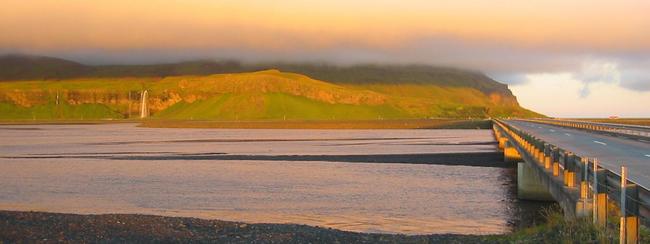
approaching Seljalandsfoss: the Markarfljót floodplain
We stopped at Seljalandsfoss, which was an unearthly colour in the evening light, but eventually reached Skógar at 9.15. By the time we'd put up our tent and cooked pasta for dinner it was nearly 11.30. The campsite is a huge grassy stretch, right near the waterfall (Skógafoss), whose roar lulled us to sleep.
It was misty and there was condensation on the tent.
The morning was bright and clear. "Fossbuin" was closed, so we could neither shower nor pay for the campsite. We packed everything ready for our hike, but then went to check out the Skógar Folk Museum.
This consists of a number of buildings: old farmhouses, many of them with turf walls, a reconstructed church and schoolhouse, a large modern building housing the folk exhibits, and a brand new Technology and Transport Museum. Þordur Tomasson, the curator who inspired the museum, is still going strong, and he performed for us on one of the little organs, singing along, and on a dulcimer.
A few of the many interesting items included Halldor Laxness' copy of Njal's Saga, a case of puzzles, a complete fishing boat, some stuffed animals, and an exhibition on the history of Iceland's power system.
Then it was back to Skógafoss to start our hike. After a discussion with some other campers there, we decided to go all the way to Þórsmörk, rather than going up to Fimmvorðuháls Pass and back. You can see the start of the track on the right of the photo above.
Next: Skóga waterfalls
Previous: Reykjavik, Hveragerði, Eyrarbakki, Floi
[Alternative spellings: Skogar, Skogafoss, Thorsmork, Fimmvorduhals]